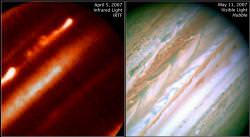As a giant planet, Jupiter takes everything to the extreme. Even the weather. A ferocious storm raging across the cloud tops has surprised scientists: it’s churning up material that was deeper down in the planet’s atmosphere. And there’s evidence that the planet’s jet streams are generated by its own heat, and not just from the Sun.
Even in the smallest telescope, it’s easy to see the distinct atmospheric bands that stretch around the planet, like a series of stripes. The strongest winds on the planet are at Jupiter’s northern latitudes. Here the winds can howl at 600 km per hour (370 miles per hour).
But astronomers have always wondered what drives these storms? Is it energy from the Sun, or is the planet’s own heat that gets the powerful jet streams driving winds across Jupiter.
In March 2007, several telescopes captured a rare atmospheric eruption, where two brand new storms appeared in the planet’s cloud tops.
The event was so well recorded because it coincided with the New Horizons spacecraft’s flyby with Jupiter. Many telescopes, including Hubble, NASA’s Infrared Telescope Facility, and a network of smaller telescopes around the world were making support observations of Jupiter.
An international team coordinated by AgustÃn Sánchez-Lavega from the Universidad del PaÃs Vasco in Spain presented their findings about this event in the January 24 issue of the journal Nature.
“Fortuitously, we captured the onset of the disturbance with Hubble, while monitoring the planet to support the New Horizons flyby observations of Jupiter in its route to Pluto. We saw the storm grow rapidly since its beginning, from about 400 kilometers [250 miles] to more than 2,000 kilometers [1,245 miles] in size in less than one day,” said Sánchez-Lavega.
With the storms, the researchers observed bright plumes of material. The newly forming storms pulled vast quantities of ammonia ice and water from deep below, and pushed it up 30 km (20 miles) above the cloud tops – higher than any other place on the planet.
By modeling the event, the researchers found that their observations supported the theory that Jupiter’s jet streams, which power the storm systems, come from much deeper inside the planet. Here on Earth, radiation from the Sun heats up the high atmosphere, and gets the jet streams going. But on Jupiter, it looks like the planet’s own heat drives these jet streams, and not the sunlight it receives.
Original Source: NASA/JPL News Release


the web site from which you have taken this part shall be the best web site and do you know that the life is forming in the galaxy please can you ask the th web site from which you have taken this note and give me the reply if you can.
Thank you too
Your web site is my favorite web site.
Is it really that surprising that Jupiter may be driving it’s own systems with internal heat, since it is known that Jupiter gives off twice as much energy as it receives from the sun?
what a awesome for New Horizons to catch and Hubble,If we ever send another mission there I’m sure they will answer some of this.
i love this it helped me so much on my science project and raised my grade from an F to a low A
thanks so much